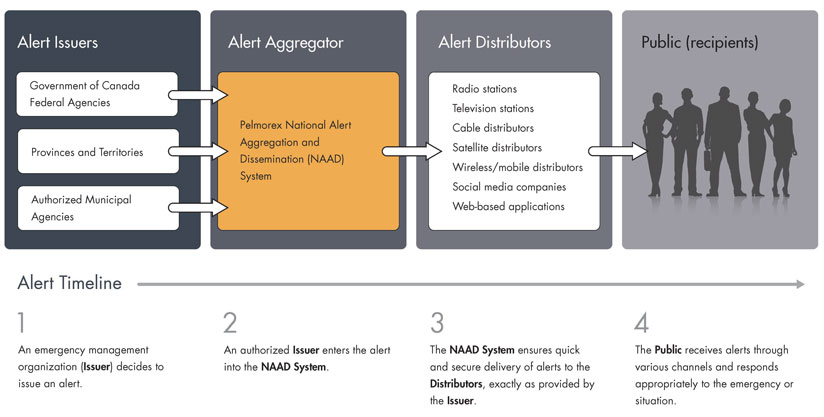National Public Alerting System
Test schedule
On May 8, 2024 a test of the National Public Alerting System will be sent out in most provinces and territories over TV, radio and wireless networks. As part of this test, Public Safety Canada will be sending the test message in select jurisdictions simultaneously.
Canadians in British Columbia, Alberta, Saskatchewan, Quebec, New Brunswick, Newfoundland and Labrador, Nunavut and Yukon will receive a test message from the Government of Canada rather than from their provincial or territorial government. A test schedule can be found on the Alert Ready website.
Canada has a National Public Alerting System (NPAS) which provides emergency management organizations across the country with the capability to rapidly warn the public of imminent or unfolding hazards to life. Public alerts are issued through radio, cable and satellite television and on compatible wireless devices.
Image Description
This image is divided into two sections. The first section is a flowchart that describes Canada’s National Public Alerting System as a “system of systems” and lists the entities responsible for alerts reaching the public.
The first section of the flowchart lists the Alert issuers which consist of the Government of Canada (Federal Agencies), Provinces and Territories, and Authorized Municipal Agencies. Arrows from each of the alert issuers point to the right to the second section of the flowchart which lists the Alert Aggregator: Pelmorex National Alert Aggregation and Dissemination (NAAD) System. An arrow from the alert aggregator points to the right to the third section of the flowchart which lists the Alert Distributors: Radio Stations, Television Stations, Cable distributors, Satellite distributors, Wireless/ mobile distributors, social media companies, and web-based applications. An arrow from the alert distributors points to the right to the final section of the flowchart: Public (recipients).
The second section of this image describes the timeline of an alert and is divided into four steps to explain how alerts reach the public.
- An emergency management organization (Issuer) decides to issue an alert.
- An authorized issuer enters the alert into the NAAD System.
- The NAAD System ensures quick and secure delivery of alerts to the Distributors, exactly as provided by the Issuer.
- The Public receives alerts through various channels and responds appropriately to the emergency or situation.
Public alerting in Canada, like all emergency management functions, is a collaborative initiative between Federal-Provincial-Territorial (FPT) governments, as well as industry partners. Working together, these partners have created a public awareness campaign on the NPAS, known as Alert Ready.
Please consult the Alert Ready website to find additional information on Canada’s alerting system, including the types of alerts that can be issued, your wireless device compatibility, what to do if an alert occurs, and links to provincial and territorial alerting programs.
Emergency management partners in Canada have been working towards an expanded NPAS for some time. With respect to wireless alerting, alerting authorities continue to use this expanded functionality as they build the capacity to do so.
For a more detailed list of events on the evolution of public alerting in Canada, view the Chronology.
Building a safe and reliable public alerting system in Canada is a responsibility shared by all levels of government and industry partners. Public Safety Canada is committed to continued engagement and collaboration to ensuring Canadians have the critical information they need in emergencies to take necessary precautions
Key Terms
National Public Alerting System (NPAS): The NPAS is a collaborative initiative between Federal-Provincial-Territorial (FPT) governments that provides emergency management organizations across the country with the capability to rapidly warn the public of imminent or unfolding hazards to life. The NPAS complements existing public alerting systems and tools in a number of FPT jurisdictions.
National Alert Aggregation and Dissemination (NAAD) System: Pelmorex Corp, owner of The Weather Network, owns and operates the central technical infrastructures for the NPAS, known as the National Alert Aggregation and Dissemination (NAAD) System. The NAAD System is one part of the larger NPAS “system-of-systems” and collects and validates emergency alerts from authorized government agencies throughout Canada and makes them available to the public.
Alert Ready: Alert Ready is the public-facing brand name for the National Public Alert System. Visit alertready.ca for more information.
Canadian Profile of the Common Alerting Protocol (CAP): The Canadian Profile of the Common Alerting Protocol (CAP-CP) is a set of rules, and managed lists of values, that are recommended for use in Canada, and overseen by the Federal/Provincial/Territorial Senior Officials Responsible for Emergency Management forum. Through the NPAS, alerts are made available in CAP format for broadcasters and other media distributors who distribute them to the Canadian public.
Common Look and Feel Guidance: The Federal/Provincial/Territorial Senior Officials Responsible for Emergency Management forum oversees The Common Look and Feel (CLF) Guidance document, which provides Last Mile Distributors with the guidance they require to ensure that the visual and audible aspects of public alerts are readily recognizable by the Canadian public, and are presented in a format that is consistent as possible across the various distribution media.
Emergency Management News Releases
Emergency Management Publications and Reports
- Government of Canada Response to the Public Order Emergency Commission Recommendations
- Advancing the Federal-Provincial-Territorial Emergency Management Strategy: Areas for Action
- Evaluation of the Initiatives to Address Post-Traumatic Stress Injuries (PTSI) Evaluation Report
- Summary of the Evaluation of the Initiatives to Address Post-Traumatic Stress Injuries (PTSI) Among Public Safety Officers
- The First Public Report of the National Risk Profile
- Date modified:
